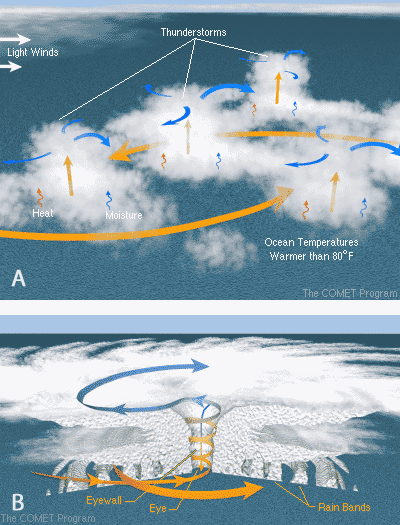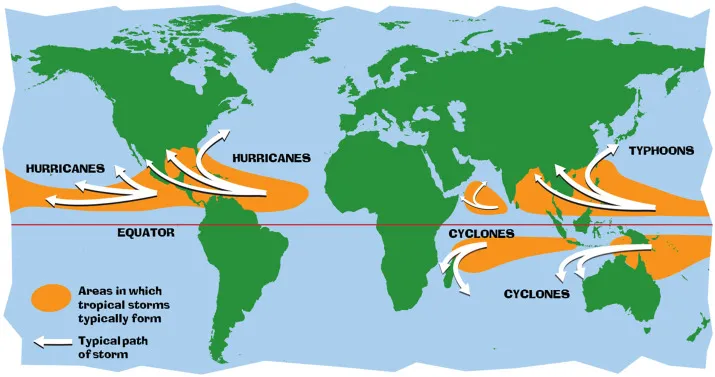How Hurricanes Form

Thunderstorms, warm ocean water and light winds are the conditions needed for a hurricane to form (A). Once formed, a hurricane consists of huge rotating rain bands with a center of clear skies called the eye which is surrounded by the fast winds of the eyewall (B).
COMET/UCAR
Off the west coast of Africa, just north of the equator, a thunderstorm forms. It is just a typical towering thunderstorm cloud, but it might grow into something quite different — a hurricane.
Perhaps several other thunderstorms form in the same area. And perhaps all those dark towering thunderstorm clouds begin to rotate around an area of low atmospheric pressure called a tropical depression. Drawing enough energy from the warmth of the tropical ocean water, these circling thunderstorms might grow into a single tropical storm with winds blowing more than 39 miles per hour (63 kph). If it grows even larger and winds swirl faster than 74 miles per hour (119 kph), it is called a hurricane.
The Right Conditions for a Hurricane to Form
All of the conditions must be just right in order for a hurricane to form, and those conditions only occur within certain latitudes, during the warmest months of the year.
What Does a Hurricane Need?
- Warm water. Hurricanes take energy from the warm ocean water to become stronger. While a hurricane is over warm water it will continue to grow.
- Low air pressure. Because of low pressure at its center, winds flow toward the center of the storm and air is forced upward. High in the atmosphere, winds flow away from the storm, which sustains the cycle of rising air from below.
- Warm, moist air. The air that rises needs to be warm and moist so that it forms heavy storm clouds. The air above tropical ocean waters is very warm and moist.
- Low wind shear. A hurricane also needs the winds outside the storm to be light. These winds steer the storm but are not strong enough to disrupt it.
How Does a Hurricane Begin to Form?
When humid air is flowing upward at a zone of low pressure over warm ocean water, the water is released from the air, creating clouds that grow into a strong storm. As it rises, the air in a hurricane rotates. Air drawn into the center of a hurricane curves to the right in the Northern Hemisphere and toward the left in the Southern Hemisphere due to the Coriolis effect — a phenomenon in which winds curve because of the Earth's rotation.
The storm will grow if there is a continuous supply of energy from warm ocean water and warm, moist air and potentially turn into a tropical storm. Storms weaken when they move over areas with cooler ocean water. There isn’t nearly as much energy in colder water to fuel the storm, nor is there as much humidity in the air. Hurricanes also weaken when they travel over land.
Where do Hurricanes Form?

NOAA
For a hurricane to form, there needs to be warm ocean water and moist, humid air. These conditions occur in the tropical areas of the world, typically between five and 20 degrees latitude north and south of the equator. However, hurricanes cannot form within 300 miles (500 kilometers) of the equator because there is no Coriolis effect there. These storms are called hurricanes in the Atlantic and are called typhoons and tropical cyclones in other parts of the world.
As a Storm Grows, It Changes
As a storm grows, it goes through a series of stages. First, it starts as a tropical disturbance. Then, with cyclonic circulation and faster wind speeds, it becomes a tropical depression. If the wind keeps getting faster it becomes a tropical storm. Tropical storms can grow into hurricanes if winds are more than 74 miles per hour (119 kph), and hurricanes can grow into stronger hurricanes. However, only a small number of storms grow into tropical storms. Even fewer become hurricanes. This is because all of the conditions listed above must occur at the same time and place, which is a pretty rare occurrence. Only about 10 tropical storms form per year, and only a few of those turn into hurricanes.
Storm Stages
The classifications in the table below are based on the wind speeds in the storm, not the size of the storm. Hurricanes that look small on radar can have very high wind speeds, and large storms can have low wind speeds. Wind speeds in hurricanes are often measured in knots. Compared to a mile per hour, knots are a little bit faster: one knot is equal to 1.15 miles per hour. For example, if the wind is blowing at 10 knots, it's going 11.5 miles per hour.
| Stage | Description |
|---|---|
| Tropical disturbance | Thunderstorms with light cyclonic circulation |
| Tropical depression | Wind speeds between 20 and 34 knots (23 - 39 mph) |
| Tropical storm | Wind speeds between 35 and 64 knots (40 - 73 mph) |
| Hurricane | Wind speed greater than 64 knots (74 mph) |